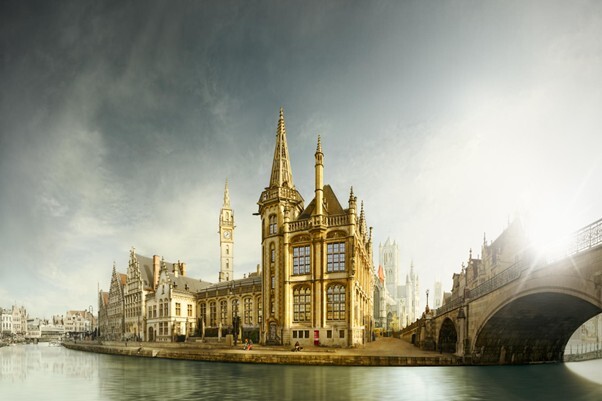David Osborn Photography - Story Components
Posted by David Osborn on 12th August 2025

Novoflex Panoramic Heads: The three less obvious reasons to choose one: Convenience,
Correction & Cost.
You can't fit the subject into the lens on your camera; the only choice is to move back to
compose everything, or change to a wide-angle lens. Recognise this scenario? In the first
scenario, the lens dictates your composition. In the second, you dislike the distortion the lens
creates. But, there's a third solution - the reason I use a Novoflex Panoramic head.
Convenience: I shoot most of my images on a 35mm or 50mm Sigma ART lens because of the
phenomenal sharpness they give, but the world doesn't fit into two lenses. Using a Novoflex
Multi-Row Panorama System means I have every focal length from fisheye to 50mm available
using just one lens. - Often, I will carry just one camera, one lens and a tripod with a Panoramic
Head. Covering the subject is not determined by the focal length of my lens, but by the number
of frames I shoot to cover the scene. I don't want to carry a bag full of lenses; I want to enjoy
taking pictures.
Correction: Wide scenes need wide lenses, but wide lenses add ugly distortion. Even if I used a
fisheye lens, I don't want the falling perspective, curvature or exaggerated distance between
near and far. I like natural-looking images, the way we see the world. Another way to correct the
perspective is a Tilt-Shift lens, or a technical camera with a digital back. However, wide lenses
still give you exaggerated spatial distances. A Panoramic Head is the only way to shoot extensive
scenes that feel natural to the eye because wide scenes can be shot with 'normal' lenses.
Cost: Imagine the price of a bag full of lenses? The price of the Novoflex Panoramic Head is way
less than the cost of a single Tilt-Shift lens, and an enormous amount less than a technical
camera with a digital back.

Picture quality: However, I prioritise the picture quality above convenience and cost. I prioritise
'Correction'.
1. I teach photography workshops. A number of my clients like shooting architecture, and
naturally, their solution is to use a Tilt-Shift lens; a correct and logical choice. However,
what I've observed is that their lens dictates where they stand; their lens dictates their
picture; this is the wrong way around. The photographer should dictate the composition,
not their lens. A Panoramic Head allows you to dictate the composition. You stand in the
best place for the picture, then shoot the number of frames required to cover the
composition. I dictate the composition, not my equipment.
2. Let's consider the picture alone. The purpose of a photograph is not the picture itself,
but the message it communicates; what we gain from looking at it. The more visually
eficient the picture is, the quicker we understand the message and gain the benefit.
Exaggerated distortions serve no benefit except as design; they are just a by-product and
signature of the tool that made the picture. If an image has significant visual distortions
from a wide-angle lens or converging verticals, it acts like friction. It's not how we see
the world; it slows down our understanding of the picture and our ability to understand
the message. Distortions are a barrier, an unnecessary layer that adds confusion. Using
a panoramic head, we create photographs without distortions (provided the horizontal
or vertical angle of view does not exceed 180° in a planar projection); the images align
with how we natural perceive the world, therefore, we relate to them more naturally and
understand the pictures more effectively.
3. Standard lenses, 35mm - 50mm range, are described as 'normal' because they best
replicate how we perceive the world with our eyes. People connect the strongest with
what's familiar. The more natural-looking the perspective in a picture, the stronger our
intuitive connection to it. Unnatural distortions stop us from bonding with the picture. By
using a 'normal' lens on a Panoramic Head, we get the best of two worlds - natural
looking images without unnatural distortions, yet the field of view of extreme wide-angle
and even fisheye lenses.
4. Speed. The next consideration is 'speed'. With moving clouds and changing light, we
can't take forever to shoot the Panoramic sequence. If we take forever, the content won't
align. We must shoot fast. The Novoflex Panoramic Head, having notches, means we
can rotate the head with total accuracy by feel, not by visually aligning time-consuming
numbers. I can shoot the complete Panoramic in 30 seconds or less; the content always
aligns. Notches mean speed.

Depending on the lens, wide-angle lenses have curvature, converging verticals, and exaggerated
spatial distance. A Novoflex Panoramic Head avoids all these problems. You create natural
looking photographs, fast, without buying or carrying a bag full of equipment - this makes
photography more enjoyable, creatively satisfying and cheaper. A panoramic head adds
incredible versatility to your photography.
I'm a Visual Educator. I help photography enthusiasts see, think and create visually. Others
teach Cameras. I teach Pictures. I run workshops teaching photography from a picture-making
perspective and solving enthusiasts' visual picture-making problems. By removing their
photography frustrations, enthusiasts enjoy photography more.
You can learn more about my workshops and tuition by visiting my website here.


